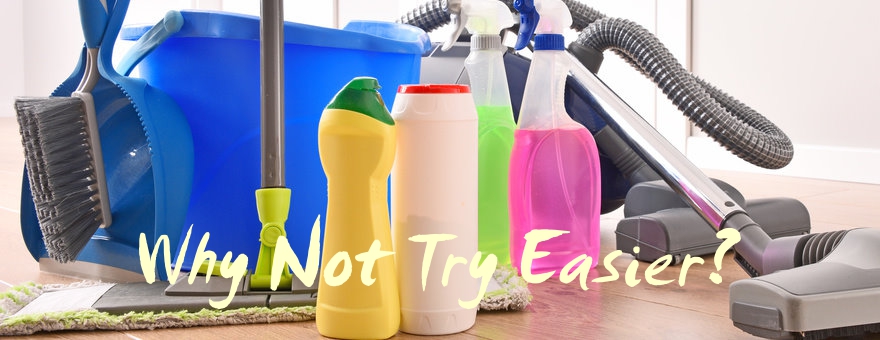
Cleaning with Scouring Cream, Scouring Powder
In the past, the secret for success of a clean kitchen floor was sand, soap and soda!
These three ingredients were – long before today’s cleaners – the answer to many stains and impurities. Sand was necessary for the “shaving” of coarse dirt, soap flakes and soda served as a fat solvent. These three additions were bought at the grocery store around the corner, and then due to its loose texture filled into a container. The modern, finely dosed and precisely matched finished products did not exist that time. Experience and sensitivity were required.
The work got easier when German company Henkel launched the ready-mixed abrasive powder under the name “ATA” in 1920. It contained only the two components sand and soda. The housewives of that time were now able to thoroughly clean dirty sinks, expired floors, burnt pots and stoves. Like this it was scrubbed and scrubbed until the 1950’s.
The sand used to clean wood and stone floors was a very fine river sand that was mined in some parts of Germany above or below ground. These days, however, this sand is no longer offered for domestic use, as the material of the floors and surfaces of tables and cabinets has also changed.
Once rough floorboards and timbers were very well cleaned with scouring sand, today’s sensitive furniture does not forgive such treatment. Nevertheless, scouring agents are indispensable for cleaning the household.
Scouring Agents in Kitchen and Bathroom
However, scourers are only suitable for surfaces where low abrasion is not important, such as stone floors, stainless steel pans or metal sinks. As a rule of thumb, most wood surfaces, painted surfaces, acrylic glass, pans and delicate plastics are not suitable for cleaning them with abrasives of any kind.
This also applies to the surfaces of sanitary porcelain, PVC floors, Plexiglas panes and tiles. These can roughen when using coarse abrasives on the surface. The consequences are a visually altered, because (slightly) scratched surface and the disadvantage that now the dirt is sometimes taken up faster and remains more in the surface. It is therefore advisable to also observe the manufacturer’s information on kitchen worktops and sanitary facilities. Or test the agent carefully at a safe place in advance.
Attention!
Avoid contact with eyes and do not breathe when using scouring powder. If it comes to eye contact, then rinse immediately with plenty of water and go to the doctor. Keep all products out of the reach of children. Not suitable for leather, linoleum, treated wood surfaces or aluminum, painted surfaces, plastic and acrylic glass. Scouring cream should be shaken briefly before use.
Scouring Cream or Scouring Powder?
If scouring products are used, scrubbing must be done by hand. Unfortunately, the “wipe and done” principle does not work. For milder cleaning liquid scouring cream is the agent of choice. It often contains very finely ground marble powder or chalk, as well as soap, acids, preservatives and fragrances. The cream should be applied undiluted to the dirty surfaces and rubbed in with a slightly damp cloth or sponge and then rubbed off. Then rinse with clear water and dry.
The classic scouring powder is a rustic cleaner for coarse impurities. It contains scouring particles such as marble flour or pumice, and may also contain soda. The powder dissolves very well firmly adhering encrustations and the particularly stubborn dirt. For cleaning, the powder is sprinkled directly onto the dirty surfaces and rubbed off with a damp cloth or sponge. It may be necessary to repeat this process several times. Finally, rinse well with clean water and wipe dry.
The scrubbing particles used today are mostly a mixture of 25% kaolinite and 75% ground quartz, which has a strong abrasive effect. On sensitive surfaces, however, it can cause scratches. Depending on the application, it makes sense to test the product in an inconspicuous place. For the degreasing effect a little detergent can be added. The cleaning is done with a damp, soft cloth on which the lubricant is sprinkled. Now work the part to be cleaned well. Then rinse with water.
What we ever wanted to know about Scouring Agents
The effect of all scouring products consists mainly in the mechanical abrasion of the adhering dirt. So they contain to develop their effect predominantly minerals, which guarantee the abrasive (abrasive) and polishing effect. In addition, the surface of the dirt crust is roughened, the moisture can better on the dirt and soften it. The average grain size of the polishing agent used must not exceed the size of 0.05 mm, otherwise the surface to be cleaned will be scratched completely.
The hardness of the polishes used is crucial. Well suited are pumice, calcium carbonate, kaolinite, soapstone or marble powder. Quartz-containing cleaners are only to be used carefully due to the high hardness of quartz. The exact components on the packaging are usually not marked. In many cases, only the name calcium carbonates can be found. With a share of more than 95%, they form the basis of a cleaner, along with surfactants, auxiliaries and builders as well as soda or acids. Surfactants are especially useful when greasy soiling is involved. Some agents contain bleaches such as peroxide or hypochlorite. Fragrances are also sometimes added, often in the direction of “lemon”.